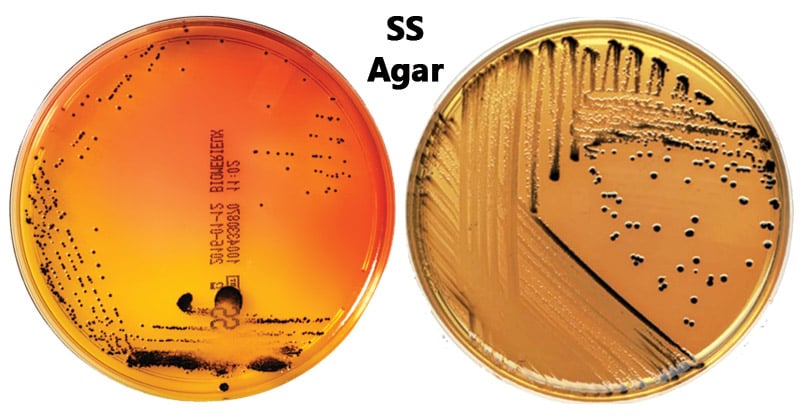Salmonella Shigella (SS) Agar is a moderately selective and differential medium for the isolation, cultivation, and differentiation of Salmonella spp. and some strains of Shigella spp. SS Agar is a modification of the Deoxycholate Citrate Agar. It is recommended for testing clinical specimens and food testing for the presence of Salmonella spp. and some Shigella spp. SS Agar is a moderately selective medium in which gram-positive bacteria are inhibited by bile salts, brilliant green, and sodium citrate. Salmonella Shigella (SS) Agar is highly selective for Salmonella species but is inhibitory to some strains of Shigella. It was developed to aid in the differentiation of lactose and non-lactose-fermenters from clinical specimens, suspected foods, and other such samples.
Interesting Science Videos
Composition of Salmonella Shigella (SS) Agar
| Ingredients | Gms/liter |
| Lactose | 10.0 |
| Bile salts no.3 | 8.5 |
| Sodium citrate | 8.5 |
| Sodium thiosulfate | 8.5 |
| Beef extract | 5.0 |
| Proteose peptone | 5.0 |
| Ferric Citrate | 1.0 |
| Brilliant green | 0.00033 |
| Neutral red | 0.025 |
| Agar | 13.5 |
Final pH 7.0 +/- 0.2 at 25ºC.
Principle of Salmonella Shigella (SS) Agar
Salmonella Shigella agar comprises bile salts, sodium citrate, brilliant green, an enzymatic digest of casein, beef extract, an enzymatic digest of animal tissue, thiosulphate, ferric citrate, neutral red, and agar. The inclusion of Bile Salts, Sodium Citrate, and Brilliant Green serve to inhibit gram-positive, coliform organisms and inhibit swarming Proteus spp. while allowing Salmonella spp. to grow. Beef Extract, Enzymatic Digest of Casein, and Enzymatic Digest of Animal Tissue provide sources of nitrogen, carbon, and vitamins required for organism growth. Lactose serves as a carbohydrate source in Salmonella Shigella Agar. Differentiation of enteric organisms is achieved by the incorporation of lactose in the medium. Organisms that ferment lactose produce acid which, in the presence of the neutral red indicator, results in the formation of red/pink colonies. Lactose non-fermenters form colorless colonies. Sodium thiosulfate and Ferric Citrate permit detection of hydrogen sulfide by the production of colonies with black centers. Neutral red turns red in the presence of an acidic pH, thus showing fermentation has occurred.
Preparation of Salmonella Shigella (SS) Agar
- Suspend 60 g of the medium in one liter of deionized or distilled water.
- Mix well.
- Heat with frequent agitation and boil for one minute.
- Do not autoclave the media.
- Pour into plates.
- Let the agar solidify and store in the refrigerator (avoid freezing). Prepared culture media can be kept for at least a week in refrigeration.
Result Interpretation on Salmonella Shigella (SS) Agar

| Organisms | Result |
| Shigella | Clear, colorless, transparent |
| Escherichia coli | Small, pink to red |
| Enterobacter, Klebsiella | Larger than E.coli, mucoid, pale, opaque cream to pink |
| Salmonella | Colorless, transparent, with a black center if H2S is produced |
| Proteus | Colorless, with a black center |
Uses of SS Agar
- It is used as a selective and differential medium for the isolation of Salmonella and some Shigella species from clinical and non-clinical specimens.
- This medium is not recommended for the primary isolation of Shigella.
- It was also developed to aid in the differentiation of lactose and non-lactose-fermenters from clinical specimens, suspected foods, and other such samples.
Limitations of SS Agar
- The incorporation of brilliant green into this medium makes it highly selective, and has been shown to inhibit the growth of some Shigella.
- The bile salts may crystallize over time. They appear as small spider-like puff balls within the medium and do not affect the performance of the medium.
- Some strains of Shigella, such as Shigella sonnei and S. dysenteriae serovar 1, may ferment lactose relatively slowly, and colonies change to lactose-fermenting after cultivation for 2 or more days.
- A few non-pathogenic organisms may grow on Salmonella Shigella agar.
- It is recommended that biochemical, immunological, molecular, or mass spectrometry testing be performed on colonies from pure culture for complete identification.

Why is SS agar not autoclaved? The components of the SS formula are common in other culture media that are sterilized in an autoclave. The concrete answer to this question has never been revealed!
Good day! May I respectfully request more pictures of Salmonella Shigella agar with positive results? negative results?
Thanks for your helping the researchers my God bless you and long lasting and good relationship
Good day! May I respectfully request more pictures of Salmonella Shigella agar with positive results? negative results?